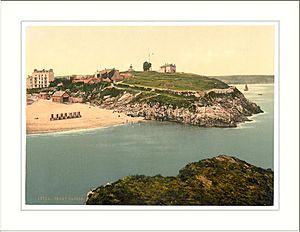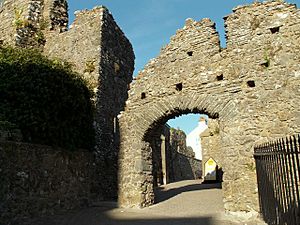Tenby Castle facts for kids
Tenby Castle (which is Castell Dinbych-y-pysgod in Welsh) was a strong fort built on a piece of land that sticks out into the sea. This land was connected to the town of Tenby in Pembrokeshire, Wales, by a narrow strip of land called an isthmus. The stone parts of the castle you can still see today were built in the 1200s. However, people talked about the castle even earlier, around 1153. It is now a special old building, known as a Grade II* listed building.
Contents
History of Tenby Castle
How the Castle Was Built

The Normans, who were people from France, built Tenby Castle in the 1100s. They built it on a rocky point during their invasion of West Wales. They first built a stone tower on the highest part of the land. This tower was protected by a strong outer wall called a curtain wall. This wall had a main gate and a few smaller towers on the side facing the land. A smaller wall also protected the rest of the castle area near the sea and the beach.
Early Attacks and Changes
In 1153, Welsh leaders Maredudd ap Gruffydd and Rhys ap Gruffydd attacked and destroyed the castle. Rhys ap Gruffydd later became a powerful ruler in South Wales. The Welsh attacked the castle again in 1187. About 100 years later, in 1260, Llywelyn ap Gruffudd, a prince from North Wales, attacked the town of Tenby. He was trying to take back control of South Wales. Even though he attacked the town, he did not capture the castle.
Why the Castle Was Left Alone
By the late 1200s, Tenby Castle and the town became part of an area called the Marcher Lordship of Pembroke. This area was ruled by William de Valence, 1st Earl of Pembroke. He was a French knight who had helped King Henry III. William de Valence started building strong stone walls around the town of Tenby.
By the early 1300s, most of the Tenby town walls were finished. This meant the castle was not as important for defending the town anymore. In 1328, the town walls were made even stronger. A D-shaped tower called a barbican was built to protect the main town gate. More D-shaped towers were added to the northern and southern parts of the walls later. By the 1400s, the family that ruled the area had no more heirs. Tenby Castle was then left empty and started to fall apart.
Making the Defenses Stronger Again
In 1457, King Henry VI gave the area to his half-brother, Jasper Tudor. Jasper Tudor agreed to fix and improve Tenby's defenses. He shared the cost with the town's merchants. They made the dry ditch outside the town walls much wider, about 30 feet across. They also made the walls taller, adding a second level of arrow slits for archers. New towers were built at the ends of the walls where they met the cliffs.
In the mid-1500s, during the Elizabethan period, another large D-shaped tower was built. This tower was called the "Five Arches." It was built because people were worried about another attack from Spain.
In 1648, during the Second English Civil War, a group of soldiers loyal to the King, called Royalists, held Tenby. They had made the town stronger again. They held out for 10 weeks until soldiers from Parliament, called Parliamentarians, surrounded them and cut off their food supply. The Royalists eventually had to give up.
Tenby Castle Today
Today, you can still see some parts of the old castle. A path goes from Tenby harbour up to the top of Castle Hill. This path goes through what used to be the main gateway. At the very top of the hill, there is a small tower. There is also a circular path that was made in the 1800s. This path follows where the original outer walls of the castle once stood. The Tenby Museum & Art Gallery is built on the remains of the castle's old living quarters, which was probably the great hall.
Even though the north gate of the town walls was taken down to make the road wider, most of the Tenby town walls on the north side are still standing. The walls and towers on the eastern side are also still complete.
Images for kids




